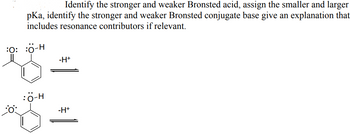
Chemistry
10th Edition
ISBN: 9781305957404
Author: Steven S. Zumdahl, Susan A. Zumdahl, Donald J. DeCoste
Publisher: Cengage Learning
expand_more
expand_more
format_list_bulleted
Concept explainers
Question
Identify the stronger and weaker Bronsted acid, assign the smaller and larger
pKa, identify the stronger and weaker Bronsted conjugate base give an explanation that
includes resonance contributors if relevant.

Transcribed Image Text:Identify the stronger and weaker Bronsted acid, assign the smaller and larger
pka, identify the stronger and weaker Bronsted conjugate base give an explanation that
includes resonance contributors if relevant.
:0: 0-H
:Ö-H
+H-
+H-
Expert Solution
This question has been solved!
Explore an expertly crafted, step-by-step solution for a thorough understanding of key concepts.
Step by stepSolved in 3 steps with 9 images

Knowledge Booster
Learn more about
Need a deep-dive on the concept behind this application? Look no further. Learn more about this topic, chemistry and related others by exploring similar questions and additional content below.Similar questions
- Arrange the following in order of decreasing basicity. MgO, Cs20, Cl207, SnO2, P4010 O Cs20 > SnO2 > MgO > P4010 > Cl207 Cl20, > P4010 > SnO2 > Cs20 > MgO O MgO > Cs20 > P4010 > SnO2 > Cl207 O Cs20 > MgO > SnO2 > P4010 > Cl207 O MgO > Cs20 > SnO2 > P4010 > Cl,07arrow_forward3.4 Bronsted-Lowry Acidity: Factors Affecting the Stability of Anions Considering the protons highlighted in red in the two compounds shown below, which compound is more acidic. HO II O Il is the stronger acid because its conjugate base is better stabilized by solvation. O lis the stronger acid because its conjugate base is stabilized by resonance. O l is the stronger acid because its conjugate base is better stabilized by solvation. O Il is the stronger acid because its conjugate base is better stabilized by induc e effects. Save for Later SAMSUNG %23 & 4 6. 7 8.arrow_forwardWhich compound is more acidic and why? I thought it would be the right, because nitrogen has a hydrogen attached to it, but oxygen is more electronegative than nitrogen, but doesn't have a hydrogen readily available (other than the methyl group on the other side).arrow_forward
- Given the following compounds, put them in order from least to most acidic (based from most the acidic proton) hydrochloric acid, acetic acid, ethanol, water, ammonia, propyne, propene, cyclopentadiene, trichloroacetic acid, hydrogen sulfide phenol, 4-methoxyphenol, 4-nitrobenzoic acidarrow_forwardwhich has the lowest ph at equilibrium? cyanic acid, formic acid, lactic acid, propionic acid, or benzoic acid?arrow_forwardPlease don't provide handwriting solutionarrow_forward
- 1) a) Predict the products of the following acid-base reactions b)draw the electron flow that leads to the products c)indicate wether the equilibrum lies to the left or right of the equlibrium arrow 2) A)for each compound show its conjugate base. Show all valence electrons and any resonance structures b)rank the conjugate base in the order you would predict from most to least stables c)rank the original compounds in order from strongest to weakest acid.arrow_forwardHaving difficulty understandingarrow_forward3. Clonidine shown below is a top selling drug used to treat hypertension. Circle the most basic atom in clonidine, provide the structure of the conjugate acid if this atom was protonated and the two best resonance structures of the conjugate acid. CI H Clonidine conjugate acidarrow_forward
- Give correct detailed Solution with explanation needed with structure ..don't give Handwritten answer..don't use Ai for answering thisarrow_forward5. In each pair, which species is a stronger base? Justify your answer. Farrow_forwardArrange the follwoing in order of decreasing basicity. OH-, CH3COOH, CH3CH2-, NH2-, NH3, Cl- How would I solve this question? what concepts should I look into when comparing bascity? Thank You!!arrow_forward
arrow_back_ios
SEE MORE QUESTIONS
arrow_forward_ios
Recommended textbooks for you
 ChemistryChemistryISBN:9781305957404Author:Steven S. Zumdahl, Susan A. Zumdahl, Donald J. DeCostePublisher:Cengage Learning
ChemistryChemistryISBN:9781305957404Author:Steven S. Zumdahl, Susan A. Zumdahl, Donald J. DeCostePublisher:Cengage Learning ChemistryChemistryISBN:9781259911156Author:Raymond Chang Dr., Jason Overby ProfessorPublisher:McGraw-Hill Education
ChemistryChemistryISBN:9781259911156Author:Raymond Chang Dr., Jason Overby ProfessorPublisher:McGraw-Hill Education Principles of Instrumental AnalysisChemistryISBN:9781305577213Author:Douglas A. Skoog, F. James Holler, Stanley R. CrouchPublisher:Cengage Learning
Principles of Instrumental AnalysisChemistryISBN:9781305577213Author:Douglas A. Skoog, F. James Holler, Stanley R. CrouchPublisher:Cengage Learning Organic ChemistryChemistryISBN:9780078021558Author:Janice Gorzynski Smith Dr.Publisher:McGraw-Hill Education
Organic ChemistryChemistryISBN:9780078021558Author:Janice Gorzynski Smith Dr.Publisher:McGraw-Hill Education Chemistry: Principles and ReactionsChemistryISBN:9781305079373Author:William L. Masterton, Cecile N. HurleyPublisher:Cengage Learning
Chemistry: Principles and ReactionsChemistryISBN:9781305079373Author:William L. Masterton, Cecile N. HurleyPublisher:Cengage Learning Elementary Principles of Chemical Processes, Bind...ChemistryISBN:9781118431221Author:Richard M. Felder, Ronald W. Rousseau, Lisa G. BullardPublisher:WILEY
Elementary Principles of Chemical Processes, Bind...ChemistryISBN:9781118431221Author:Richard M. Felder, Ronald W. Rousseau, Lisa G. BullardPublisher:WILEY

Chemistry
Chemistry
ISBN:9781305957404
Author:Steven S. Zumdahl, Susan A. Zumdahl, Donald J. DeCoste
Publisher:Cengage Learning

Chemistry
Chemistry
ISBN:9781259911156
Author:Raymond Chang Dr., Jason Overby Professor
Publisher:McGraw-Hill Education

Principles of Instrumental Analysis
Chemistry
ISBN:9781305577213
Author:Douglas A. Skoog, F. James Holler, Stanley R. Crouch
Publisher:Cengage Learning

Organic Chemistry
Chemistry
ISBN:9780078021558
Author:Janice Gorzynski Smith Dr.
Publisher:McGraw-Hill Education

Chemistry: Principles and Reactions
Chemistry
ISBN:9781305079373
Author:William L. Masterton, Cecile N. Hurley
Publisher:Cengage Learning

Elementary Principles of Chemical Processes, Bind...
Chemistry
ISBN:9781118431221
Author:Richard M. Felder, Ronald W. Rousseau, Lisa G. Bullard
Publisher:WILEY